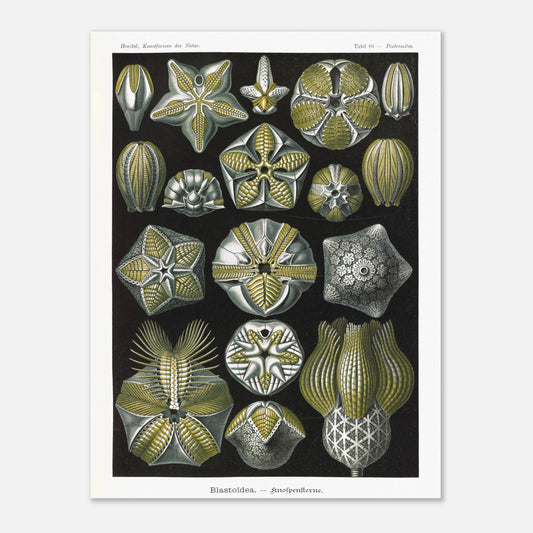Blastoids - Zoological and botanical plate - Ernst Haeckel, Kunstformen der Natur
Blastoids - Zoological and botanical plate - Ernst Haeckel, Kunstformen der Natur
Couldn't load pickup availability
Engraving reproduction of: Blastoids
Original title Blastoidea - Knospensterne
Poster of Pentremites - Starfish of the Blastoid class
Illustration from the book Kunstformen der Natur, which is a collection of artistic lithographs of natural sciences published by the German biologist Ernst Haeckel between 1899 and 1904.
This naturalistic illustration is part of an overall style inspired by Ernst Haeckel, which greatly influenced the emerging Art Nouveau movement at the beginning of the 20th century. This work, illustrating the impressive beauty and great diversity of the biological world, was complemented by a certain amount of scientific information, some excerpts of which are reproduced below.
This information is over 120 years old and some of it may be outdated!
Scientific classification:
Phylum Echinoderms (Echinoderma) Main class of Pentorchonia (Pentorchonia) Class Blastoidea
Scientific notice (extract) accompanying the poster print of Blastoidea - Blastoïdes :
The button stars or sea buttons (Blastoidea) form a very special class of the echinoderm phylum; they are known to us only from their fossilized remains. These calcareous carapaces are exclusively limited to the Paleozoic era, which dates back at least 14 million years; they already appear in the Lower Silurian, become more frequent in the Devonian and reach their maximum development in the Carboniferous; the class becomes extinct at the end of the Carboniferous period. All Blastoids lived fixed on the seabed, often attached by a short stalk; the posture of the five-sided pyramidal body was therefore the same as that of their direct ancestors, the Cystoids (Cystoidea, Plate 90), and of the crinoids (Crinoidea, Plate 20). Opposite the lower basal pole of the main vertical axis of the body is the mouth, in the center of the apical pole. The mouth forms the center of a five-pointed star-like figure, the anthodium. This consists of five perradial ambulacral fields, which have a very complex structure, which we only partially understand. In the vast majority of button stars, the Eublastoidea, the five ambulacra are of equal shape and size; in contrast, they are remarkably unequal in the small order Parblastoidea (Figs. 4 and 10). Here, the posterior ambulacrum (facing the anus) is much shorter and wider than the other four ribbon-like ambulacral fields. Furthermore, the eccentric position of the anus (in the posterior interradial field) suggests bilateral symmetry in the five-sided pyramidal structure of the body of all button stars. The mouth is surrounded by five pairs of apertures that behave in a similar way to those of brittle stars (Ophiodea, Plates 10 and 70); They probably served, as in the latter, for the evacuation of genital products. Most of the time, these ten genital slits (which are also interpreted as respiratory openings and called "hydrospires") are located in pairs between the apical ends of the ambulacra. The lateral edges of the latter were bordered by a row of small mobile pinnules (Pinnulae), whose articulated calcareous skeleton is only rarely well preserved (Fig. 3 above, Fig. 12). Folded inwards, these pinnules (which correspond to the pinnules on the free arms of the crinoids, Plate 20) covered the entire anthodium (in Fig. 3, the two upper lateral ambulacra). All the figures in this plate are slightly enlarged. The ambulacra are colored yellow.
Species present on the Blastoids - Pentremites naturalist plate :
- Pentremites pyriformis
- Pentremites orbignyanus
- Pentremites sp.
- Zygocrinus cruciatus
- Orophocrinus stelliformis
- Phaenoschisma acutum
- Elaeacrinus olivanites
- Elaeacrinus verneuili
- Codonaster trilobatus
- Eleutherocrinus cassedayi
- Asteroblastus stellatus
- Asteroblastus volborthi
About this print
About this print
The layout and composition of this reproduction have been the subject of our greatest attention.
- Respect for the format of the original work: in order to faithfully transcribe the artist's intention, the work is not cropped/re-cut except in extreme cases (obvious imperfection, geometry problem, etc.) in which case the cropping will be as light as possible.
- The presence of white margins is sometimes necessary in order to present the work in a balanced manner.
- Each size offered has been specifically composed, therefore, the size of the white margins may vary from one print size to another. Remember to check this detail carefully!
- Print only, frame not included!
Features
Features
- Premium 200gsm matte white paper, durable and strong.
- Natural, smooth uncoated finish, silky to the touch
- FSC certified paper or equivalent certifications depending on regional availability.
- Each print is shipped in sturdy packaging, ensuring safe transport.
- Each print is printed and shipped on demand. No minimum order quantity is required.
Share !









Recently viewed products
We are listening to you
If you are looking for a specific composition, a particular layout, or any other customization need, our team is at your disposal and will do everything possible to meet your requests.
So don't hesitate to...




